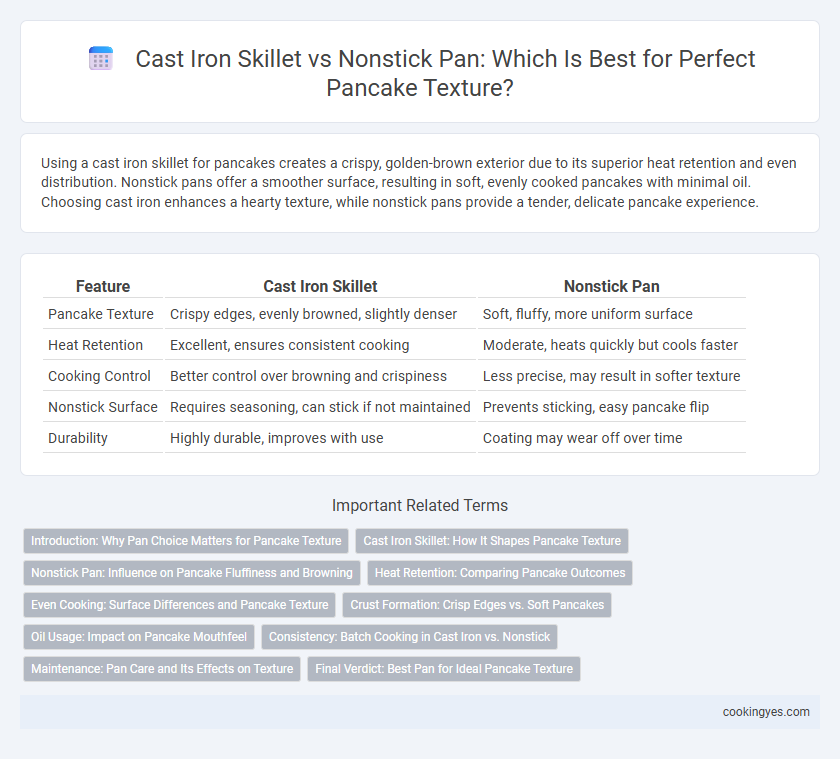Using a cast iron skillet for pancakes creates a crispy, golden-brown exterior due to its superior heat retention and even distribution. Nonstick pans offer a smoother surface, resulting in soft, evenly cooked pancakes with minimal oil. Choosing cast iron enhances a hearty texture, while nonstick pans provide a tender, delicate pancake experience.
Table of Comparison
| Feature | Cast Iron Skillet | Nonstick Pan |
|---|---|---|
| Pancake Texture | Crispy edges, evenly browned, slightly denser | Soft, fluffy, more uniform surface |
| Heat Retention | Excellent, ensures consistent cooking | Moderate, heats quickly but cools faster |
| Cooking Control | Better control over browning and crispiness | Less precise, may result in softer texture |
| Nonstick Surface | Requires seasoning, can stick if not maintained | Prevents sticking, easy pancake flip |
| Durability | Highly durable, improves with use | Coating may wear off over time |
Introduction: Why Pan Choice Matters for Pancake Texture
The choice between a cast iron skillet and a nonstick pan significantly impacts pancake texture due to differences in heat retention and surface interaction. Cast iron skillets distribute heat evenly and develop a naturally seasoned surface that creates a crispy, golden crust. Nonstick pans offer a smoother surface that promotes a fluffy interior but may lack the robust browning and crisp edges characteristic of cast iron cookware.
Cast Iron Skillet: How It Shapes Pancake Texture
Cast iron skillets distribute heat evenly and retain high temperatures, creating a crispy, golden-brown crust that enhances pancake texture. The skillet's seasoning layer prevents sticking while adding subtle, smoky flavors unique to cast iron cooking. Compared to nonstick pans, cast iron skillets produce thicker, more textured pancakes with a satisfying crunch on the outside and tender interior.
Nonstick Pan: Influence on Pancake Fluffiness and Browning
Nonstick pans provide an even heat distribution that enhances pancake fluffiness by preventing hot spots and ensuring consistent cooking. The smooth surface of nonstick pans minimizes sticking, allowing pancakes to rise evenly without tearing, which contributes to a tender texture. Additionally, nonstick coatings promote uniform browning by maintaining steady temperatures, resulting in pancakes with a golden, appealing crust.
Heat Retention: Comparing Pancake Outcomes
Cast iron skillets excel in heat retention, ensuring consistent, even cooking that produces pancakes with a perfectly browned, crispy exterior and tender interior. Nonstick pans heat up quickly but often lose heat rapidly when batter is added, resulting in uneven cooking and less desirable texture. The superior heat stability of cast iron notably enhances pancake texture by preventing hot spots and maintaining temperature throughout the cooking process.
Even Cooking: Surface Differences and Pancake Texture
Cast iron skillets provide superior even cooking due to their excellent heat retention and distribution, resulting in pancakes with a crispy exterior and uniform golden-brown texture. Nonstick pans heat up quickly but often have uneven surface temperatures, which can lead to inconsistent pancake texture with less crispiness. The rougher surface of cast iron also promotes better caramelization, enhancing the pancake's flavor and overall texture compared to the smoother nonstick coating.
Crust Formation: Crisp Edges vs. Soft Pancakes
Cast iron skillets excel at crust formation, producing pancakes with crisp, golden edges due to their superior heat retention and even distribution. Nonstick pans typically yield softer pancakes with less browning, as their lower heat retention prevents the formation of a robust crust. Choosing cast iron enhances texture through a satisfying crunch, while nonstick prioritizes tenderness in each bite.
Oil Usage: Impact on Pancake Mouthfeel
Cast iron skillets require less oil due to their naturally nonstick surface developed through seasoning, resulting in pancakes with a crispier, more textured exterior. Nonstick pans need a thin layer of oil to prevent sticking, which can lead to softer, smoother pancakes with a more uniform mouthfeel. The amount and type of oil used directly influence the pancake's texture, with cast iron enhancing a richer, slightly caramelized flavor profile.
Consistency: Batch Cooking in Cast Iron vs. Nonstick
Cast iron skillets provide superior heat retention and even cooking, ensuring consistent pancake texture throughout batch cooking, while nonstick pans may have uneven heat distribution causing variability between pancakes. Cast iron's ability to maintain steady temperatures allows for uniform browning and a crispy edge, essential for high-quality pancakes in larger batches. Nonstick pans often require lower heat settings and frequent adjustments, which can result in inconsistent texture and cooking times during extended batch cooking.
Maintenance: Pan Care and Its Effects on Texture
Cast iron skillets require regular seasoning and careful cleaning to maintain their nonstick surface, which enhances pancake texture by promoting even browning and crispy edges. Nonstick pans demand gentle washing and avoidance of metal utensils to preserve the coating, ensuring consistent pancake softness and preventing texture degradation. Proper pan maintenance directly influences the final pancake's mouthfeel and appearance by preserving optimal heat distribution and surface condition.
Final Verdict: Best Pan for Ideal Pancake Texture
Cast iron skillets provide superior heat retention and even cooking, resulting in pancakes with a perfectly crisp exterior and fluffy interior. Nonstick pans offer convenience and easy release but may lack the high-heat searing that enhances pancake texture. For achieving the ideal pancake texture, a preheated cast iron skillet remains the best choice.
Cast iron skillet vs nonstick pan for pancake texture Infographic

 cookingyes.com
cookingyes.com